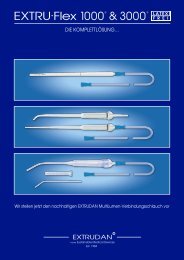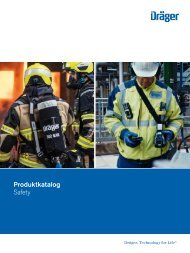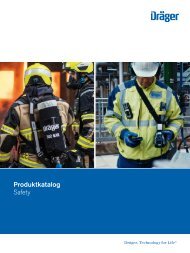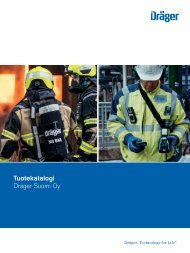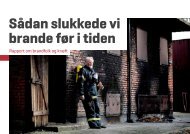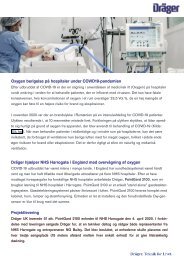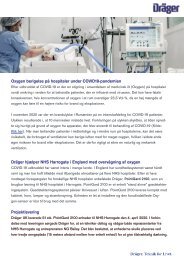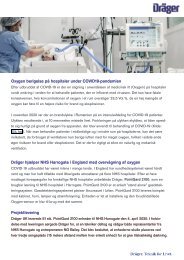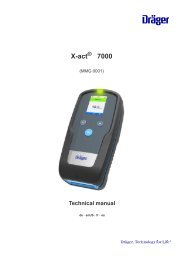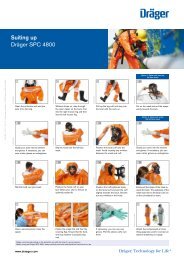Carcinogenic Substances at Work
Create successful ePaper yourself
Turn your PDF publications into a flip-book with our unique Google optimized e-Paper software.
MERCURY<br />
Mercury – chemical and<br />
physical properties 1<br />
SELECTED INTERNATIONAL WORKPLACE EXPOSURE LIMITS<br />
FOR MERCURY (8 HOURS TWA)<br />
CAS no. 7439-97-6<br />
Country/Region<br />
Parts per<br />
million<br />
Mg/m³<br />
Appearance and colour:<br />
Melting point:<br />
Boiling point:<br />
Silver shining<br />
-38.87 °C<br />
356.72 °C<br />
Europe – 0.02<br />
Germany – 0.02<br />
USA (ACGIH) –<br />
TWA 0.1 (aryl)<br />
TWA 0.025 (inorg.)<br />
China –<br />
Singapore –<br />
0.04 (PC-STEL CN)<br />
0.02 (PC-TWA CN<br />
PEL (ST) 0.03 (Alkyl compounds)<br />
PEL (LT) 0.01 (Alkyl compounds)<br />
PEL (LT) 0.1 (Aryl compounds)<br />
PEL (LT) 0.025 (Inorganic forms + metal)<br />
Is your country not included? <br />
Visit our hazardous substances d<strong>at</strong>abase VOICE for more<br />
inform<strong>at</strong>ion: www.draeger.com/voice<br />
MEASUREMENT OF MERCURY<br />
Measuring mercury or mercury vapour is<br />
a challenge for the industry. Due to its<br />
very specific properties, special measuring<br />
instruments are usually required for clearance<br />
measurement or regular spot measurements.<br />
Now this is fast and easy possible with a new<br />
analysis system. The Dräger X-act® 7000<br />
analysis device with MicroTubes measure<br />
mercury in the range of 0.005–0.25 mg/m 3 .<br />
It is able to replace a conventional labor<strong>at</strong>ory<br />
analysis and delivers exact results on site.<br />
The Dräger tube for mercury vapor with a<br />
measuring range of 0.05–2 mg/m 3 can also<br />
be used.<br />
Dräger<br />
X-act® 7000<br />
Dräger Shortterm<br />
Tubes<br />
Find more inform<strong>at</strong>ion<br />
about suitable measuring<br />
equipment in the chapter<br />
"Measuring carcinogens".<br />
1 IFA. (n.d.-a). GESTIS Substance d<strong>at</strong>abase - Mercury. Gestis Substance D<strong>at</strong>abase. Retrieved July 14, 2020, from http://gestis-en.itrust.de/nxt/g<strong>at</strong>eway.dll/gestis_en/000000.<br />
xml?f=templ<strong>at</strong>es$fn=default.htm$vid=gestiseng:sdbeng$3.0<br />
2 https://www.who.int/news-roomWorld Health Organiz<strong>at</strong>ion: WHO. (2017, March 31). Mercury and health. WHO - Mercury and Health. https://www.who.int/news-room/fact-sheets/detail/mercuryand-health/fact-sheets/detail/mercury-and-health<br />
3 Ines Rutschmann, I. R. (2016, June 2). Giftiger Bohrschlamm - Reinigen st<strong>at</strong>t in der Erde verbuddeln. Deutschlandfunk. https://www.deutschlandfunk.de/giftiger-bohrschlamm-reinigen-st<strong>at</strong>t-inder-erde-verbuddeln.676.de.html?dram:article_id=355974<br />
4 CDC. (n.d.). ATSDR - ToxFAQsTM: Mercury. Toxic <strong>Substances</strong> Portal - Mercury. https://www.<strong>at</strong>sdr.cdc.gov/toxfaqs/tf.asp?id=113&tid=24<br />
21 | 33




